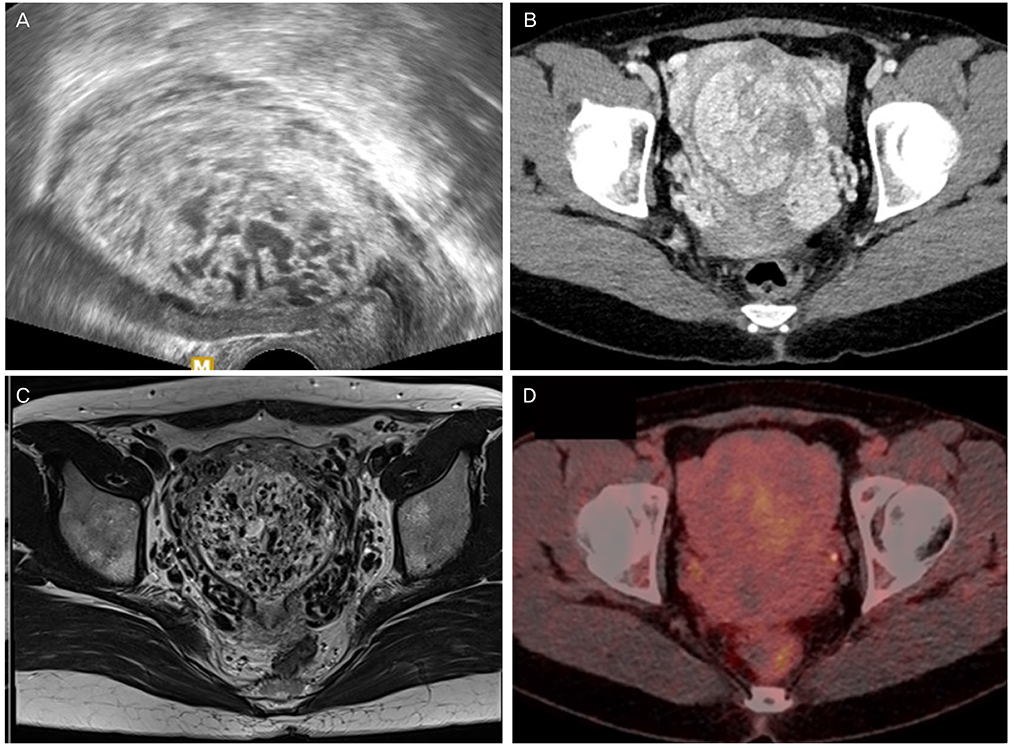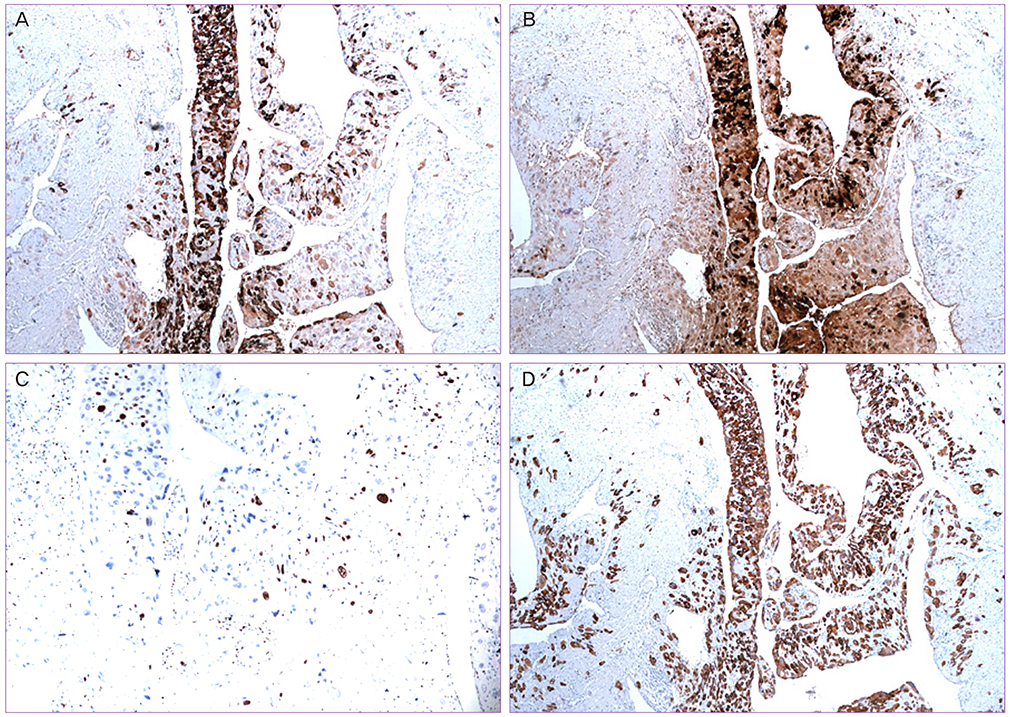Obstet Gynecol Sci.
2018 May;61(3):319-327. 10.5468/ogs.2018.61.3.319.
Clinical characteristics and outcomes of placental site trophoblastic tumor: experience of single institution in Korea
- Affiliations
-
- 1Department of Obstetrics and Gynecology, Samsung Medical Center, Sungkyunkwan University School of Medicine, Seoul, Korea. bgkim@skku.edu
- 2Department of Pathology, Samsung Medical Center, Sungkyunkwan University School of Medicine, Seoul, Korea.
- KMID: 2416119
- DOI: http://doi.org/10.5468/ogs.2018.61.3.319
Abstract
OBJECTIVE
Placental site trophoblastic tumor (PSTT) is the rarest form of gestational trophoblastic disease (GTD) and the optimum management is still controversial. In this study, we analyzed the clinical features, treatment, and outcomes of 6 consecutive patients with PSTT treated in our institution.
METHODS
The electronic medical record database of Samsung Medical Center was screened to identify patients with PSTT from 1994 to 2017. Medical records for the details of each patient's clinical features and treatment were extracted and reviewed. This study was approved Institutional Review Board of our hospital.
RESULTS
A total of 418 cases of GTD, 6 (1.4%) patients with PSTT were identified. The median age of the patients was 31 years. The antecedent pregnancy was term in all 5 cases with available antecedent pregnancy information and the median interval from pregnancy to diagnosis of PSTT was 8 months. The median titer of serum beta human chorionic gonadotropin (β-hCG) at diagnosis was 190.9 mIU/mL. Five (83.3%) patients presented with irregular vaginal bleeding and one (16.7%) had amenorrhea. All patients had disease confined to the uterus without metastasis at diagnosis and were successfully treated by hysterectomy alone. All of them were alive without disease during the follow-up period.
CONCLUSION
In this study, we observed low level serum β-hCG titer and irregular vaginal bleeding with varying interval after antecedent term pregnancy were most common presenting features of PSTT. In addition, we demonstrated hysterectomy alone was successful for the treatment of stage I disease of PSTT.
MeSH Terms
-
Amenorrhea
Chorionic Gonadotropin
Diagnosis
Electronic Health Records
Ethics Committees, Research
Female
Follow-Up Studies
Gestational Trophoblastic Disease
Humans
Hysterectomy
Korea*
Medical Records
Neoplasm Metastasis
Pregnancy
Prognosis
Trophoblastic Tumor, Placental Site*
Uterine Hemorrhage
Uterus
Chorionic Gonadotropin
Figure
Reference
-
1. Behnamfar F, Mousavi A, Rezapourian P, Zamani A. Placental site trophoblastic tumor, report of a case with unusual presentation. Placenta. 2013; 34:460–462.
Article2. Kurman RJ, Scully RE, Norris HJ. Trophoblastic pseudotumor of the uterus: an exaggerated form of “syncytial endometritis” simulating a malignant tumor. Cancer. 1976; 38:1214–1226.3. Scully RE, Young RH. Trophoblastic pseudotumor: a reappraisal. Am J Surg Pathol. 1981; 5:75–76.4. Luiza JW, Taylor SE, Gao FF, Edwards RP. Placental site trophoblastic tumor: Immunohistochemistry algorithm key to diagnosis and review of literature. Gynecol Oncol Case Rep. 2014; 7:13–15.
Article5. Piura B, Rabinovich A, Meirovitz M, Shaco-Levy R. Placental site trophoblastic tumor: report of four cases and review of literature. Int J Gynecol Cancer. 2007; 17:258–262.
Article6. Baergen RN, Rutgers JL, Young RH, Osann K, Scully RE. Placental site trophoblastic tumor: a study of 55 cases and review of the literature emphasizing factors of prognostic significance. Gynecol Oncol. 2006; 100:511–520.
Article7. Ngan HY, Bender H, Benedet JL, Jones H, Montruccoli GC, Pecorelli S, et al. Gestational trophoblastic neoplasia, FIGO 2000 staging and classification. Int J Gynaecol Obstet. 2003; 83:Suppl 1. 175–177.
Article8. Huang F, Zheng W, Liang Q, Yin T. Diagnosis and treatment of placental site trophoblastic tumor. Int J Clin Exp Pathol. 2013; 6:1448–1451.9. Shih IM. Trophogram, an immunohistochemistry-based algorithmic approach, in the differential diagnosis of trophoblastic tumors and tumorlike lesions. Ann Diagn Pathol. 2007; 11:228–234.
Article10. Zheng Y, Bao L, Ning Y, Lu X, Hua K, Yi X. Retrospective analysis of the clinicopathologic and prognostic characteristics of stage I placental site trophoblastic tumor in China. Int J Gynaecol Obstet. 2015; 129:67–70.
Article11. Saso S, Haddad J, Ellis P, Lindsay I, Sebire NJ, McIndoe A, et al. Placental site trophoblastic tumours and the concept of fertility preservation. BJOG. 2012; 119:369–374.
Article12. Lan C, Li Y, He J, Liu J. Placental site trophoblastic tumor: lymphatic spread and possible target markers. Gynecol Oncol. 2010; 116:430–437.
Article13. Horowitz NS, Goldstein DP, Berkowitz RS. Placental site trophoblastic tumors and epithelioid trophoblastic tumors: biology, natural history, and treatment modalities. Gynecol Oncol. 2017; 144:208–214.
Article14. Lurain JR. Gestational trophoblastic disease II: classification and management of gestational trophoblastic neoplasia. Am J Obstet Gynecol. 2011; 204:11–18.
Article15. Feltmate CM, Genest DR, Wise L, Bernstein MR, Goldstein DP, Berkowitz RS. Placental site trophoblastic tumor: a 17-year experience at the New England Trophoblastic Disease Center. Gynecol Oncol. 2001; 82:415–419.
Article16. Chen Y, Zhang X, Xie X. Clinical features of 17 cases of placental site trophoblastic tumor. Int J Gynaecol Obstet. 2011; 115:204–205.
Article17. Hassadia A, Gillespie A, Tidy J, Everard RG, Wells M, Coleman R, et al. Placental site trophoblastic tumour: clinical features and management. Gynecol Oncol. 2005; 99:603–607.
Article18. Schmid P, Nagai Y, Agarwal R, Hancock B, Savage PM, Sebire NJ, et al. Prognostic markers and long-term outcome of placental-site trophoblastic tumours: a retrospective observational study. Lancet. 2009; 374:48–55.
Article19. Zhao J, Lv WG, Feng FZ, Wan XR, Liu JH, Yi XF, et al. Placental site trophoblastic tumor: a review of 108 cases and their implications for prognosis and treatment. Gynecol Oncol. 2016; 142:102–108.
Article20. Chang YL, Chang TC, Hsueh S, Huang KG, Wang PN, Liu HP, et al. Prognostic factors and treatment for placental site trophoblastic tumor-report of 3 cases and analysis of 88 cases. Gynecol Oncol. 1999; 73:216–222.
Article21. Hyman DM, Bakios L, Gualtiere G, Carr C, Grisham RN, Makker V, et al. Placental site trophoblastic tumor: analysis of presentation, treatment, and outcome. Gynecol Oncol. 2013; 129:58–62.
Article
- Full Text Links
- Actions
-
Cited
- CITED
-
- Close
- Share
- Similar articles
-
- A Case of Placental Site Trophoblastic Tumor
- Epithelioid trophoblastic tumor: A Case Report and Review of the Literature
- A Case of Placental Site Trophoblastic Tumor
- Epitheilioid Trophoblastic Tumor of the Lung: A Case Report
- A case of chemoresistant placental site trophoblastic tumor in a patient who wants to remain fertile




